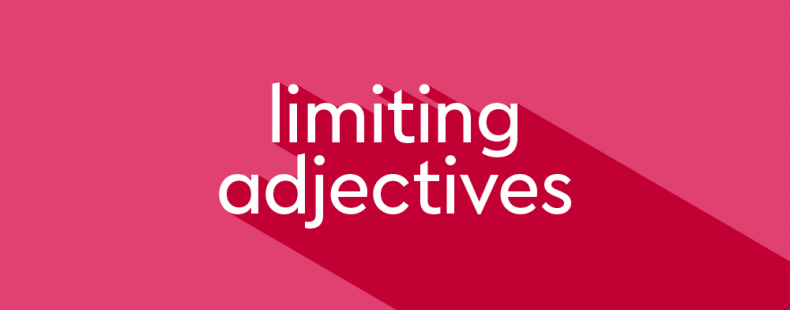Call yourself a grammar expert? Then you already know that adjectives are words that modify or describe nouns and pronouns. However, there is a certain type of adjective that isn’t too keen on the whole task of “describing” things. These adjectives are known as limiting adjectives. Limiting adjectives are much more interested in restricting a noun or pronoun than describing something about it. But don’t worry. You aren’t restricted from learning more about these adjectives, which you are free to do by reading on.
What is a limiting adjective?
A limiting adjective is an adjective that modifies a noun or pronoun by restricting it rather than describing the qualities or traits of it. Limiting adjectives are contrasted to descriptive adjectives, which do describe nouns and pronouns.
What does this mean? Let’s first look at an example of a descriptive adjective:
- Katia owns friendly cats.
The descriptive adjective friendly modifies the noun cats. This adjective describes the cats: it tells us that the cats are pleasant to be around and like making friends. We have learned something about cats that allows us to describe them.
Now, let’s look at an example of limiting adjective:
- Kat owns some cats.
The limiting adjective some modifies the noun cats. This adjective restricts the cats by saying that Katia owns more than one cat. More importantly, the adjective some doesn’t describe anything about the cats. We don’t know what the cats look like, how they act, or anything else about them. We haven’t learned any information that would help us describe these specific cats.
This lack of description is what makes limiting adjectives unique. Unlike most adjectives, limiting adjectives restrict a noun or pronoun by singling it out or stating it belongs to a specific group without describing it or mentioning its qualities.
Types of limiting adjectives
There are far fewer limiting adjectives compared to descriptive adjectives. In general, most style guides and grammar resources consider any adjective that doesn’t describe a noun/pronoun to be a limiting adjective. Several different types of adjectives are often considered to be limiting adjectives.
Demonstrative adjectives
Demonstrative adjectives do not describe nouns or pronouns. Instead, they are used to indicate relative physical location or moments in time. The demonstrative adjectives are:
- this, that, these, those
Interrogative adjectives
Interrogative adjectives limit a noun by asking a question about a specific person, place, or thing without describing it. The interrogative adjectives are:
- whose, what, which
Quantifying adjectives
Quantifying adjectives limit nouns and pronouns by grouping them together or by saying how much of a quantity of something there is. These adjectives do not describe the qualities of the nouns/pronouns they modify.
Quantifying adjectives include words such as:
- many, some, few, couple, any, all, several
Numbers, both ordinal and cardinal, also limit nouns and pronouns to specific amounts when used as adjectives.
- cardinal numbers: one, ten, thirty, one million
- ordinal numbers: first, fifth, seventieth
Possessive adjectives
Many style guides consider possessive adjectives to be limiting adjectives. This is likely due to the fact that while a possessive adjective does say who or what has ownership of something, it doesn’t actually describe the qualities or characteristics of a noun or pronoun. In this way, possessive adjectives limit a noun without actually describing it.
The possessive adjectives are:
- my, your, his, her, its, our, their, and whose
Articles
If a style guide or grammar resource considers articles to be adjectives rather than determiners, they probably consider articles to be limiting adjectives. Articles do not describe nouns or pronouns when they modify them. In English, the three articles are:
- a, an, the
Where do you include a limiting adjective in a sentence?
Most of the time, limiting adjectives are used before the nouns and pronouns they modify:
- This movie is hilarious.
- He found 10 paperclips in the drawer.
- She was looking for some people to help her raise money for charity.
Typically, it doesn’t make grammatical sense to use a limiting adjective as a subject complement, which is a word or a group of words, usually functioning as an adjective or noun, that is used in the predicate. For example:
- The butterflies were three in the garden.
- I looked in the pantry until I found the cookies that were some.
- The book is my.
However, some limiting adjectives, especially quantitative adjectives, are used as subject complements:
- The scientists were worried that wild pandas were few in number.
- She is going to hear all of my complaints, and there are many.
Limiting adjective examples in a sentence
The following sentences all use limiting adjectives. As you read each one, you’ll notice that none of these adjectives actually describe the qualities of the nouns and pronouns they modify.
Example #1
- Ashley likes this dress more than that one. (The limiting adjectives this and that limit the noun dress and pronoun one by specifying their physical locations relative to the speaker.)
Example #2
- Chef Gustav added some spices to the soup. (The limiting adjective some limits the noun spices by stating the general quantitative amount.)
Example #3
- The kindergarten class worked on their projects. (The limiting adjective their limits the noun projects by stating the projects are the ones that specifically belong to the kindergarten class.)
Limiting adjective rules & best practices
Because they don’t describe nouns or pronouns, it usually doesn’t make grammatical sense to form comparative or superlative adjectives from them. For example, you typically wouldn’t say that something is “the five-est” or say that something is “this-er” or “more its” than something else.
When are some good instances for using comparative adjectives? Find out here.
When we use limiting adjectives to describe nouns, they are placed before descriptive nouns in adjective order. For example, we would say Jim bought those red apples rather than Jim bought red those apples. As another example, we would say I need 10 empty buckets rather than I need empty 10 buckets.
No limit to what you’ll learn with Grammar Coach™
Improve your writing with Thesaurus.com’s Grammar Coach™, which catches grammar and spelling errors and provides Thesaurus-powered synonym suggestions. Using machine learning, this tool can definitely spot the difference between the trickiest adjectives and help you use them correctly. Start writing smarter today!















